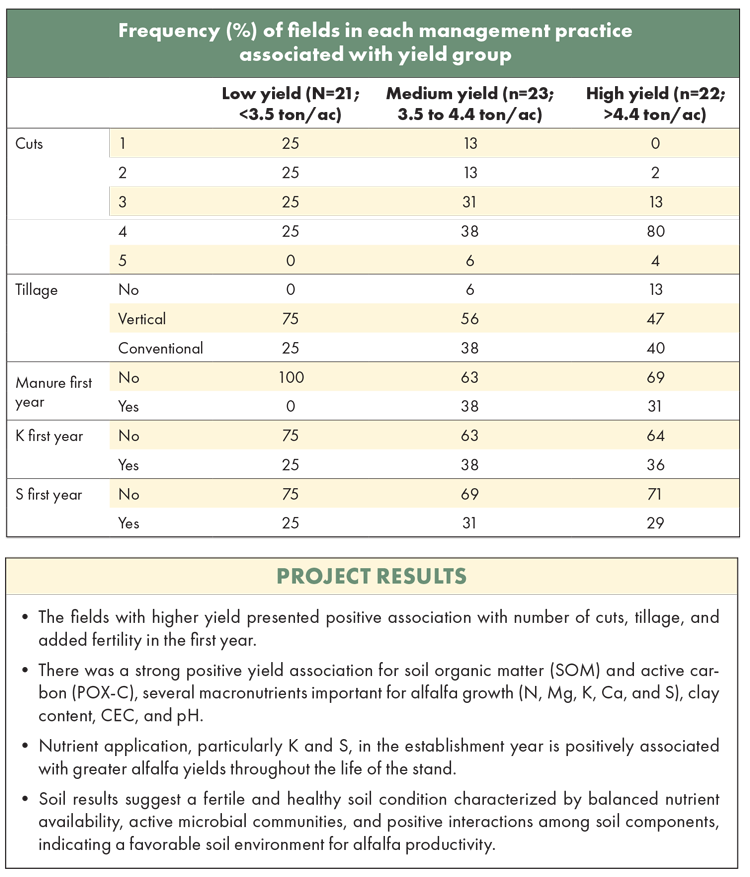
While alfalfa may be a key element of sustainable agricultural systems due to its well-known environmental and ecosystem benefits, the reported average yield of alfalfa for U.S. farms is well below the potential of what growers could produce. To help answer the question of “How do we close that alfalfa yield gap?” Nicole Tautges, agroecologist at the Michael Fields Agricultural Institute, along with the University of Wisconsin’s Valentin Picasso, was awarded funding from NAFA’s Alfalfa Checkoff to identify critical relationships between alfalfa yields, management practices, and soil fertility and health indicators.

“It all stemmed from this realization that alfalfa yields in controlled research trials — at a university research station or at a company research farm — are significantly higher than average yields on farms,” said Tautges. “While that’s not atypical for crops, the yield gap for alfalfa is a lot higher than for other crops. The question is, ‘Why is that going on, and how are people managing their alfalfa?’ That was what spurred this study.”
The project was intended to build upon a Midwest Forage Association-funded management survey that identified farms with high alfalfa yields and the production practices they used by adding a soil fertility and health assessment to on-farm data collection activities; compiling a database that combines alfalfa production, management practices, and soil parameters; and identifying critical relationships between alfalfa yields, management practices, and soil fertility and health.
Specific goals for the project were to identify alfalfa management practices associated with high yields, generate data that makes the case for alfalfa as a soil health crop, and demonstrate the importance of managing alfalfa for soil health and economic gains.
Start stands right
“The biggest message we gleaned from the survey data was that management in the establishment year really matters and has an effect on stand health throughout the life of the alfalfa stand,” Tautges said. The management practices that maximized alfalfa yields most were the number of cuts, tillage type, and manure application, as well as the use of potassium (K) and sulfur (S) in the first year, suggesting that nutrient application in the establishment year is positively associated with greater alfalfa yields throughout the life of the stand (see Table 1).

Additionally, strong positive relationships emerged between soil carbon pools (SOM and POX-C) and critical soil components for alfalfa growth, including pH, K, S, calcium (Ca), and cation exchange capacity (CEC). Overall, these findings highlight the significance of maintaining a good nutrient supply to ensure higher alfalfa yields throughout the stand’s life and suggest that a fertile and healthy soil characterized by balanced nutrient availability, active microbial communities, and positive interactions among soil components can provide a favorable soil environment for alfalfa productivity.
Tautges added, “I think we feel relatively confident in the management practice findings that we have for fertilizing in the first year, but that cutting intensity signal is pretty high from what we can parse from the data. That is a major outcome. All farmers who are growing alfalfa should plan on that unless it’s a drought year. Otherwise, you are not getting the most economic benefit that you can from your alfalfa.
“I think the next step in this research is to do purposeful experimental manipulations of these different factors, including fertilization and/or manure application in the establishment year, to evaluate the effects it has on soil biology-alfalfa plant relationships, and how these relationships enhance plant health, vigor, yield, and forage quality,” she concluded.
A full copy of the final report can be found at alfalfa.org.
This article appeared in the March 2024 issue of Hay & Forage Grower on pages 30-31.
Not a subscriber? Click to get the print magazine.

